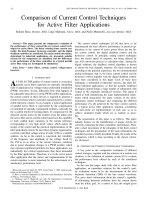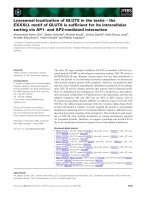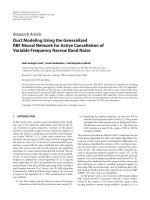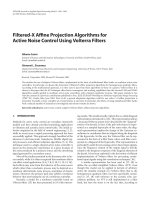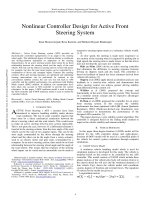Multifunctional folate conjugated polymeric micelles for active intracellular drug delivery
Bạn đang xem bản rút gọn của tài liệu. Xem và tải ngay bản đầy đủ của tài liệu tại đây (3.22 MB, 214 trang )
MULTIFUNCTIONAL FOLATE CONJUGATED
POLYMERIC MICELLES FOR ACTIVE
INTRACELLULAR DRUG DELIVERY
ZHAO HAIZHENG
NATIONAL UNIVERSITY OF SINGAPORE
2007
MULTIFUNCTIONAL FOLATE CONJUGATED
POLYMERIC MICELLES FOR ACTIVE
INTRACELLULAR DRUG DELIVERY
ZHAO HAIZHENG
(B. Eng. & M. Eng., TIANJIN UNIVERSITY, PRC)
A THESIS SUBMITTED
FOR THE DEGREE OF DOCTOR OF PHILOSOPHY
DEPARTMENT OF CHEMICAL & BIOMOLECULAR ENGINEERING
NATIONAL UNIVERSITY OF SINGAPORE
2007
I
Acknowledgements
Firstly, I would like to thank my supervisor, Dr. Lanry Yung, for his support, guidance
and inspiration during my Ph.D. work in these four years. His rigorous methodology,
objectivity and enthusiasm in research showed me the qualities required to succeed in the
research field. He also created a scientific and amiable lab environment for the students.
His advice will serve me in all aspects of life.
Special thanks are also given to National University of Singapore for its financial support.
I would also like to thank the faculty and stuff in the Chemical and Biomolecular
Engineering for their support, especially Ms. Li Xiang, Ms. Li Fengmei, Mr. Han
Guangjun, Mr. Boey Kok Hong and Ms. Tay Choon Yen. I also appreciate the support of
lab officers from other departments of NUS, Ms. Kho Jia Yann from the Insitu
Hybridization Lab, Mr. Ong Ling Yeow and Mr. Toh Kok Tee from the Flow Cytometry
Lab, Mr. James Low from the Animal Holding Unit.
I am grateful to my colleagues and fellow graduate students, Mr. Zhong Shaoping, Mr.
Qin Weijie, Mr. Zhu Xinhao, Mr. Khew Shih Tak, Mr. Tan Chau Jin, Weiling, Deny and
phuoc. They not only help me on my research, but also offer great friendship which is so
important to me. I would also like to thank my friends from Tianjin University who are
also doing Ph.D. in our department. With their friendship and support, I have a wonderful
time while I am far away from China.
Finally, I am most grateful to my parents and my brother whose love, support and
understanding made this work possible. I also deeply appreciate my husband, without his
support and encouragement, I would not have completed this Ph.D. research.
II
Table of Contents
Acknowledgements I
Table of Contents II
Summary VI
List of Figures IX
List of Tables XIV
Chapter 1 Introduction 1
1.1 Background 1
1.2 Aims and scope of this project 2
Chapter 2 Literature Review 5
2.1 Tumor specific chemotherapy 5
2.1.1 Side effects of traditional chemotherapy 5
2.1.2 Anatomical, physiological and pathological considerations 6
2.1.3 Tumor Targeting 10
2.2 Multidrug resistance of Chemotherapy 24
2.3 Drug Delivery Systems 26
2.3.1 Liposomes 27
2.3.2 Polymeric microparticles/nanoparticles 29
2.3.3 Polymer-drug conjugates 30
2.3.4 Polymeric Micelles 32
Chapter 3 The synthesis and characterization of PLGA-PEG-FOL micelles 34
3.1 Introduction 34
3.2 Materials and methods 35
3.2.1 Materials 35
3.2.2 Synthesis of Conjugates 35
3.2.3 Characterization of polymers 41
3.2.4 Preparation of DOX-loaded PLGA-PEG-FOL micelles 42
3.2.5 Characterization of polymer micelles 42
3.2.6 In vitro drug release 45
3.3 Results and discussion 46
3.3.1 Synthesis and characterization of PLGA-PEG-FOL conjugate 46
3.3.2 Properties of copolymer micelles 52
3.3.3 In vitro drug release 60
3.4 Conclusions 61
Chapter 4 Selectivity of folate conjugated polymer micelles for anticancer drug delivery
62
4.1 Introduction 62
4.2 Materials and methods 63
4.2.1 Materials 63
4.2.2 Preparation and characterization of DOX-loaded micelles 63
4.2.3 In vitro cell culture studies 64
III
4.2.4 Statistical analysis 67
4.3 Results and discussion 67
4.3.1 Characterization of DOX-loaded micelles 67
4.3.2 Expression of folate receptors in different cell lines 68
4.3.3 Cytotoxicity Test 68
4.3.4 Cellular uptake of DOX 71
4.3.5 Cell cycle analysis 73
4.3.6 The effect of folate content on micelles to targeting efficiency 78
4.4 Conclusions 80
Chapter 5 pH-triggered drug release for active intracellular drug delivery 81
5.1 Introduction 81
5.2 Materials and methods 83
5.2.1 Materials 83
5.2.2 Synthesis of the poly(β-amino ester)-PEG-FOL conjugate 83
5.2.3 Characterization of polymers 84
5.2.4 Preparation and characterization of DOX-loaded micelles 86
5.2.5 Acid-base titration 86
5.2.6 Physicochemical properties of polymer micelles 86
5.2.7 In vitro cell experiments 87
5.2.8 Statistical analysis 87
5.3 Results and discussion 87
5.3.1 Characterization of poly(β-amino ester)-PEG-FOL copolymer 87
5.3.2 Buffering capacity of the polymers 89
5.3.3 The effects of pH values on the physicochemical properties of micelles 90
5.3.4 Critical association concentration (CAC) 92
5.3.5 In vitro drug release 95
5.3.6 Cytotoxicity Test 97
5.3.7 Cellular uptake of DOX 100
5.4 Conclusions 102
Chapter 6 Folate conjugated polymer micelles formulated with TPGS 103
6.1 Introduction 103
6.2 Materials and methods 104
6.2.1 Materials 104
6.2.2 Preparation of DOX-loaded micelles 105
6.2.3 Physicochemical properties of polymer micelles 106
6.2.4 Drug release study 106
6.2.5 In vitro cellular assays 107
6.2.6 Statistical analysis 109
6.3 Results and discussion 110
6.3.1 Physicochemical properties of DOX-loaded PLGA-PEG-FOL micelles.110
6.3.2 In vitro drug release 112
6.3.3 Cellular DOX uptake 113
6.3.4 Cytotoxicity Test 118
6.3.5 Apoptosis assay 122
IV
6.3.6 Accumulation of rhodamine in Caco-2 cells 123
6.4 Conclusions 126
Chapter 7 The pharmacokinetics and tissue distribution of folate conjugated polymer
micelles 127
7.1 Introduction 127
7.2 Materials and methods 128
7.2.1 Materials 128
7.2.2 In vitro cell culture studies 128
7.2.3 Subcutaneous tumor growth 129
7.2.4 Pharmacokinetics of the four drug formulations 129
7.2.5 Biodistribution study 130
7.3 Results and discussion 131
7.3.1 Tumor growth 131
7.3.2 Pharmacokinetics of the DOX-loaded micelles 133
7.3.3 Biodistribution 135
7.3.4 Tumor and heart morphology analysis 142
7.4 Conclusions 146
Chapter 8 Potential use of cholecalciferol polyethylene glycol succinate as a novel
pharmaceutical additive 147
8.1 Introduction 147
8.2 Materials and methods 148
8.2.1 Materials 148
8.2.2 Synthesis of cholecalciferol polyethylene glycol succinate (CPGS) 149
8.2.3 Characterization of CPGS 151
8.2.4 Preparation of DOX-loaded PLGA nanoparticles 151
8.2.5 Characterization of polymer nanoparticles 151
8.2.6 Accumulation of rhodamine in Caco-2 cells 152
8.2.7 Cytotoxicity assay 153
8.2.8 Statistical analysis 153
8.3 Results and discussion 154
8.3.1 Characterization of CPGS 154
8.3.2 Critical micelles concentration (CMC) of CPGS 158
8.3.3 The effect of CPGS on physicochemical properties of nanoparticles 160
8.3.4 Drug release 162
8.3.5 Accumulation of rhodamine in Caco-2 cells 164
8.3.6 Cytotoxicity test 166
8.4 Conclusions 169
Chapter 9 Conclusions & Recommendations 170
9.1 Conclusions 170
9.2 Recommendations for future work 173
9.2.1 Effects of PEG length of folate conjugates on targeting ability and antitumor
effects 173
9.2.2 The antitumor efficacy of different drug formulations 175
V
9.2.3 The mechanism of TPGS or CPGS on the MDR inhibition 176
9.2.4 Using the current delivery system as magnetic resonance imaging (MRI)
contrast agents 178
Reference 180
Appendix Ι 195
Appendix II 198
VI
Summary
Many chemotherapy treatments have significant side effects because non-specific
delivery of anticancer drugs damages healthy organs. Folate or folic acid has been
employed as a targeting moiety of various anticancer agents to increase their cellular
uptake within target cells since folate receptors (FRs) are vastly overexpressed in many
human tumors. In this thesis, a biodegradable polymer poly(D,L-lactide-co-glycolide)-
poly(ethylene glycol)-folate (PLGA-PEG-FOL) was used to form micelles for
encapsulating anticancer drug doxorubicin (DOX). The difference of cytotoxicity,
cellular uptake and apoptosis percentage between different cancer cells and healthy cells
implies that the folate conjugated micelles has the ability to selectively target cancer cells
that overexpress FRs on their surface. Furthermore, the amount of folate on the micelles
was optimized at 40%-65% in order to kill cancer cells but, at the same time, have
minimal effect on normal healthy cells.
To accelerate the drug release in endosome, a pH-sensitive block copolymer poly(β-
amino ester)-PEG-FOL was synthesized. This copolymer is hydrophilic at endosomal pH
of 5-6. However, under physiological environment (pH 7.4), the poly(β-amino ester)
block is hydrophobic but the PEG-FOL block is hydrophilic, resulting in the formation of
polymer micelles with poly(β-amino ester) in the core and PEG-FOL at the shell. To
control the drug release from the micelles, mixed micelles of PLGA-PEG-FOL and
poly(β-amino ester)-PEG-FOL were fabricated. The incorporation of pH-sensitive
polymer in the micelles increased the buffering ability and changed physicochemical
properties at the endosomal pH. The release of DOX in the micelles was accelerated at
VII
pH 5.0, which resulted in increased cytoplasmic concentration of DOX and improved
cytotoxicity. This formulation would be useful as an effective intracellular delivery
carrier of hydrophobic therapeutic agents.
Another serious problem associated with cancer chemotherapy is the development of
multidrug-resistant (MDR) tumor cells during the course of treatment. To overcome
MDR, a new drug formulation - PLGA-PEG-FOL formulated with d-α-tocopheryl
polyethylene glycol succinate (TPGS), known as mixed micelles, was fabricated.
Compared with the PLGA-PEG-FOL formulation, the addition of TPGS showed higher
cellular uptake of DOX, and subsequently a higher degree of DNA damage and apoptosis,
and eventually a higher cytotoxicity to drug resistant cells. The enhanced cellular uptake
of mixed micelles was related to the P-glycoprotein (P-gp) inhibition function of TPGS.
In addition, the formulations with TPGS also selectively enhance the cytotoxicity of drug
resistant cancer cells with overexpressed folate receptors and affect normal cells at
minimum. The pharmacokinetics and biodistribution of this new formulation was also
evaluated with rat tumor xenograft models. The mixed micelles formulation showed
enhanced drug accumulation in drug resistant tumors. Based on these results, the mixed
micelles may be an appropriate formulation for drug resistant tumors overexpressed FRs.
Although TPGS is an effective P-gp inhibitor, it represents only one of the surfactants in
the class of “Vitamin-PEG” conjugated surfactants. A new vitamin D-PEG conjugate -
cholecalciferol polyethylene glycol succinate (CPGS) was synthesized as a new
pharmaceutical additive. From our current study, similar to TPGS, CPGS may also act as
VIII
P-gp inhibitor to enhance the cytotoxicity of anticancer drugs. Compared with TPGS,
CPGS did not show obvious cytotoxicity to cancer cells in vitro. However, CPGS may
have anticancer effects in vivo through the active metabolites of Vitamin D. Results
obtained from this study may broaden potential use of different vitamin-based additives
for pharmaceutical formulations.
IX
List of Figures
Figure 2.1 Schematic illustration of the EPR effect principle
17
7
Figure 2.2 Structure of active targeting systems
22
11
Figure 2.3 Scheme of the antibody-drug and antibody-polymer-drug conjugates
23
12
Figure 2.4 FR-mediated endocytosis of folate-drug conjugate
37
16
Figure 2.5 Structural design of a pteroate-drug conjugate
37
18
Figure 2.6 The mechanism of MDR and MDR inhibition
86
25
Figure 2.7 Scheme of a polymer prodrug
27
31
Figure 2.8 Structure of polymeric micelles
106
33
Figure 3.1 The HPLC analysis of FOL-PEG
(a) before separation, (b) after separation 47
Figure 3.2
1
H-NMR spectrum of folic acid in DMSO-d
6
at 500 MHz 48
Figure 3.3 The
1
H-NMR spectrum of FOL-PEG 48
Figure 3.4 The
1
H-NMR spectrum of PLGA-PEG-FOL conjugate 49
Figure 3.5 Infrared spectra of PEG, activated PLGA and PLGA-PEG-FOL copolymer . 50
Figure 3.6 The GPC of (a) PEG-bisamine, (b) PLGA-PEG and (c) PLGA-PEG-FOL 51
Figure 3.7a Excitation spectra of pyrene as a function of PLGA-PEG-FOL concentration
53
Figure 3.7b Plot of intensity ratios I
335
/I
333
vs. log C of PLGA-PEG conjugate 53
Figure 3.7c Plot of intensity ratios I
335
/I
333
vs. log C of PLGA-PEG-FOL conjugate 54
Figure 3.8 XPS N
1S
region of PLGA-PEG-FOL conjugate 55
Figure 3.9 TEM images of (a) PLGA-PEG micelles and (b) PLGA-PEG-FOL micelles 56
Figure 3.10 AFM images of (a) PLGA-PEG micelles and (b) PLGA-PEG-FOL micelles
56
X
Figure 3.11 Size and size distribution of DOX-loaded PLGA-PEG-FOL micelles 58
Figure 3.12 The release profiles of the polymer micelles 61
Figure 4.1 Flow cytometry evaluation of the expression of folate receptors on different
cell lines. Cells were treated with mouse anti-FR antibody and followed by FITC-
conjugated anti-mouse IgG antibody 68
Figure 4.2 The cytotoxicity of different DOX formulations to KB cells. Bars marked with
* are significantly different from bars with the same drug concentration (p<0.05). 69
Figure 4.3 The cytotoxicity of DOX-loaded PLGA-PEG-FOL micelles to KB, MATB III,
C6 and fibroblast cells. Bars marked with * are significantly different from the fibroblasts
at the same drug concentration (p<0.05). 70
Figure 4.4 Flow cytometry histogram profiles of KB, MATB III, C6, and fibroblast cells
that were incubated with different drug formulations (DOX concentration of 10 µM). 72
Figure 4.5 Confocal images of KB, MATB III, C6, and fibroblast cells treated with
different DOX formulations. (a) KB cells treated with free DOX, (b) KB cells treated
with DOX-loaded PLGA-PEG micelles, (c) – (f) are KB cells, MATB Ш cells, C6 cells,
and fibroblast cells treated with DOX-loaded PLGA-PEG-FOL micelles respectively 74
Figure 4.6 DOX formulations induced cell cycle perturbation and apoptosis in (I) KB
cells, (II) MATB III cells, (III) C6 cells and (IV) fibroblast cells. (a) Control (untreated
cells), (b) DOX-loaded PLGA-PEG
micelles, (c) free DOX, (d) DOX-loaded PLGA-
PEG-FOL micelles 77
Figure 4.7 DOX cellular uptake as a function of folate content on the micelles 79
Figure 5.1 Synthesis of PAE-PEG-FOL conjugate 85
Figure 5.2 The
1
H-NMR spectrum of PAE-PEG-FOL conjugate 88
Figure 5.3 Acid-Base titration profiles of different micelles formulations. The polymer
solution at 0.1 mg/ml was titrated to pH 11 with 0.1 N NaOH and subsequently titrated
down with 0.1 N HCl 89
Figure 5.4 Size of PAE-PEG-FOL micelles and mixed micelles under different pH values
91
Figure 5.5a Excitation spectra of pyrene as a function of the polymer concentration 93
Figure 5.5b Plot of intensity ratios I
337.5
/I
334.5
vs. log C of mixed micelles 80:20 under
different pH values 94
XI
Figure 5.5c Plot of intensity ratios I
337.5
/I
334.5
vs. log C of mixed micelles 50:50 under
different pH values 94
Figure 5.6a The drug release profiles of the DOX-loaded mix micelles 80:20 under
different pH values 95
Figure 5.6b The drug release profiles of the DOX-loaded mix micelles 50:50 under
different pH values 96
Figure 5.7 The cytotoxicity of different DOX formulations to KB cells at pH 7.4. The
viability of each concentration repeated three times 99
Figure 5.8 Cytotoxicity of different DOX formulations to KB cells at pH 6.5. The
viability of each concentration repeated three times 99
Figure 5.9 Confocal images of KB cells treated with different drug formulations (DOX
concentration of 10 µM 101
Figure 6.1 Micelles size and size distribution of (a) TPGS micelles and (b) mixed
micelles with 10% TPGS 112
Figure 6.2 Drug release profiles of DOX-loaded PLGA-PEG-FOL micelles and mixed
micelles with different percent of TPGS. Each point represents the mean ± S.D. from
three experiments 113
Figure 6.3 Flow cytometry histogram profiles of fluorescence intensity when KB/DOX
cells were treated by (1) free DOX, (2) DOX-loaded PLGA-PEG micelles, (3) PLGA-
PEG-FOL micelles, (4) mixed micelles with 5% TPGS, (5) mixed micelles with 10%
TPGS and (6) mixed micelles with 20% TPGS 116
Figure 6.4 Flow cytometry histogram profiles of fluorescence intensity when fibroblast
cells were treated by free DOX, DOX-loaded PLGA-PEG-FOL micelles and mixed
micelles with 10% TPGS 116
Figure 6.5 Confocal images of KB/DOX cells treated with drug formulations. (a) free
DOX, (b) DOX-loaded PLGA-PEG micelles, (c) DOX-loaded PLGA-PEG-FOL micelles,
(d) DOX-loaded mixed micelles with 5% TPGS, (e) DOX-loaded mixed micelles with
10% TPGS and (f) Fibroblasts treated with mixed micelles with 10% TPGS. 117
Figure 6.6 The cytotoxicity of TPGS to KB/DOX cells and fibroblast cells 118
Figure 6.7 The cytotoxicity of free DOX, DOX-loaded PLGA-PEG micelles, PLGA-
PEG-FOL micelles and mixed micelles to KB/DOX cells. Bars marked with * are
significantly different from bars marked with + 120
XII
Figure 6.8 The cytotoxicity of DOX-loaded PLGA-PEG-FOL micelles added with 5%,
10% and 20% free TPGS to KB/DOX cells. 120
Figure 6.9 The cytotoxicity of mixed micelles to fibroblasts, respectively. Each bar
represents the mean ± S.D. from three experiments. 121
Figure 6.10 Annexin V-FITC apoptosis assay of KB/DOX cells (The portion marked
with M1 indicates the apoptotic population). 123
Figure 6.11 Cellular uptake of Caco-2 cells incubated with rhodamine formulations. 125
Figure 6.12 The rhodamine accumulation in Caco-2 cells. (a) free rhodamine, (b) PLGA-
PEG micelles, (c) PLGA-PEG-FOL micelles, (d) mixed micelles with 10% TPGS. 125
Figure 7.1 Tumors size and position 7 days after tumor cells implantation 132
Figure 7.2 The plasma drug concentration-time profiles of drug formulations after i.v.
administration at a dose of 10 mg/kg to tumor-bearing rats induced by MATB Ш cells.
134
Figure 7.3 The biodistribution of drug formulations in rat tissues after i.v. administration
against s.c. MATB Ш cells 137
Figure 7.4 The biodistribution of drug formulations in rat tissues after i.v. administration
against s.c. MATB Ш/DOX cells. 141
Figure 7.5 The tumor morphology 24 h after i.v. administration against MATB Ш cells
143
Figure 7.6 The tumor morphology 24 h after i.v. administration against MATB Ш/DOX
cells 144
Figure 7.7 The heart morphology 24 h after i.v. administration against MATB Ш/DOX
cells 145
Figure 8.1 Reaction scheme of the synthesis of CPGS 150
Figure 8.2 The
1
H-NMR spectrum of (a) Vitamin D, (b) VDS, (c) CPGS 156
Figure 8.3 The FT-IR spectrum of (a) Vitamin D, (b) VDS, (c) mPEG, (d) CPGS 157
Figure 8.4 The HPLC analysis of CPGS and TPGS 157
Figure 8.5a Excitation spectra of pyrene as a function of CPGS concentration 159
Figure 8.5b Plot of intensity ratios I
337.5
/I
334.5
vs. log C of CPGS 159
XIII
Figure 8.6 SEM images of (a) PLGA nanoparticles, (b) PLGA nanoparticles with 5%
CPGS additive 161
Figure 8.7 Drug release profiles of DOX-loaded PLGA nanoparticles without additive or
with TPGS and CPGS 163
Figure 8.8 Cellular uptake efficiency of Caco-2 cells incubated with rhodamine
formulations for 2 h. (a) Free rhodamine, (b) Rhodamine-loaded TPGS micelles, (c)
Rhodamine-loaded CPGS micelles. (b) and (c) are significantly different from (a)
(p<0.05) 165
Figure 8.9 The rhodamine accumulation in Caco-2 cells. (a) free rhodamine, (b)
rhodamine-loaded TPGS micelles, (c) rhodamine-loaded CPGS micelles 166
Figure 8.10 The cytotoxicity of DOX formulations in Caco-2 cells. Bars marked with *
are significantly different from free DOX and DOX loaded PLGA nanoparticles at the
same DOX concentration (p<0.05) 168
Figure 8.11 The in vitro cytotoxicity of TPGS and CPGS to Caco-2 cells. CPGS marked
with * are significantly different from TPGS at the same concentration (p<0.05) 168
Figure 9.1 Folate-linked microemulsions consisted of folate-linked lipids and PEG
2000
-
DSPE
197
175
Figure 9.2 Tumor volume vs. Time 176
XIV
List of Tables
Table 3.1 The molecular weight and polydispersity of the polymers 51
Table 3.2 Physicochemical characterizations of micelles 58
Table 3.3 Drug loading content and drug encapsulation efficiency of DOX-loaded
micelles 60
Table 5.1 The molecular weight and polydispersity of the polymers 88
Table 6.1 Effect of TPGS on the physicochemical properties of DOX-loaded micelles 111
Table 7.1 The plasma pharmacokinetics parameters of different drug formulations 135
Table 8.1 The effect of CPGS on the physicochemical properties of PLGA nanoparticles
161
Chapter 1
1
Chapter 1
Introduction
1.1 Background
Cancer is the second major cause of death in the U.S. Despite the significant progress in
the development of anticancer technology, there is still no common cure for patients with
malignant diseases
1
. In addition, the long-standing problem of chemotherapy is the lack
of tumor-specific treatments. Traditional chemotherapy relies on the premise that rapidly
proliferating cancer cells are more likely to be killed by a cytotoxic agent. In reality,
however, cytotoxic agents have very little or no specificity, which leads to systemic
cytotoxicity, causing severe side effects such as hair loss, damages to liver, kidney, heart
and bone marrow. Therefore, many tumor targeting methods have been developed in last
decades
2
. One of the important methods is antibody based tumor targeting
3
. The mAb
moiety of antibody binds to the antigens on cancer cells and the antibody-drug conjugates
is internalized via receptor-mediated endocytosis followed by release of the parent drug
to its active form. In 2000, Mylotarg® was approved by FDA, providing the first mAb-
drug immunoconjugate for the treatment of cancer in clinic
4
. Several other mAb-drug
conjugates, such as BR96-doxorubicin
5
and herceptin-DM1
6
are currently in the clinical
trials. Although using antibodies as cancer markers offers some advantages, antibodies
are usually expensive and inevitably increase the cost of drugs. In addition, the stability
of antibody-drug conjugates is still a problem. Therefore, it is necessary to develop
alternative targeting vehicles which are highly selective, stable and economical.
Chapter 1
2
Another significant obstacle for successful chemotherapy is multidrug resistance (MDR)
in cancer cells. MDR is a phenomenon whereby tumor cells that have been exposed to
one cytotoxic agent develop cross-resistance to a range of structurally and functionally
unrelated compounds
7
. MDR is often found in many types of human tumors that have
relapsed after an initial favorable response to drug treatment. The sensitivity of the MDR
tumor cells to anticancer drugs can decrease significantly, which hinders the efficacy of
these drugs in chemotherapy
8
. P-glycoprotein (P-gp) overexpression is one of the
mechanisms of MDR, and can result in an increased efflux of cytotoxic drugs from
cancer cells, thus lowering their intracellular concentrations. In certain cases, up to 100-
fold overexpression of P-gp in MDR cells have been observed
9
. Various strategies to
overcome MDR have been attempted. A common method is to utilize P-gp blocking
agents, such as cyclosporine A and verapamil
10, 11
. However, cyclosporine A and
verapamil are immunosuppressant drugs and can cause side effects when they are used as
MDR-reversing agents with anticancer drugs. Therefore, the development of safe and
effective MDR-reversing agents without other pharmacological activities is required.
1.2 Aims and scope of this project
The aims of this thesis is to address the above two problems in chemotherapy. Since non-
specific treatments result in the side effects of chemotherapy, one of the aims is to
develop a targeting delivery system which has high selectivity to tumors. In addition, the
system should be stable and economical, and can be produced easily. Another aim of this
project is to develop a safe and effective MDR-reversing agent without undesired
Chapter 1
3
pharmacological activities. Although current drug delivery vehicles have shown promise
in tumor targeting and MDR inhibition, few investigations have addressed the two
problems together at the same time. The challenge is to develop a new delivery system
which has targeting ability to cancer cells and at the same time overcome MDR in cancer
cells. This PhD work aims to fabricate multifunctional polymeric micelles which could
specifically target to cancer cells and overcome MDR. The scope of this thesis include
the fabrication of multifunctional polymeric micelles, the selectivity of the micelles
between cancer cells and tumor cells, the P-gp inhibition of the micelles, the synergistic
effects between the tumor targeting and P-gp inhibition, and the in vivo therapeutic
effects of the micelles.
The specific objectives of this thesis include:
1. Design a tumor targeting delivery system. A biodegradable block copolymer-
poly(D,L-lactide-co-glycolide)-poly(ethylene glycol)-folate (PLGA-PEG-FOL) was
prepared to form micelles for encapsulating anticancer drug doxorubicin (DOX). The
characterization and properties of the PLGA-PEG-FOL copolymer micelles were
fully evaluated, such as micelles size, morphology, stability, surface properties, drug
loading content and drug release.
2. Study the selectivity of the folate conjugated micelles between cancer cells and
normal cells. Until now, the selectivity of the folate conjugated micelles has not been
addressed. Therefore, in this thesis, the in vitro selectivity of the targeting delivery
Chapter 1
4
system was investigated. The difference of cytotoxicity, cellular uptake and apoptosis
percentage between different cancer cells and normal cells was studied.
3. Synthesize a pH-sensitive polymer to increase the drug cytotoxicity. After folate-
mediated endocytosis, in order to accelerate the drug release in early endosome, a pH-
sensitive polymer- poly(β-amino ester)-PEG-FOL conjugate was prepared. The
effects of the pH- sensitive polymer to drug release, cytotoxicity and cellular uptake
were investigated.
4. Fabricate multifunctional polymeric micelles which could specifically target to cancer
cells and overcome MDR. It has been demonstrated that TPGS can enhance cellular
uptake of drugs in the cancer cells by inhibiting P-gp mediated MDR
12-14
. Folate
conjugated micelles formulated with TPGS was fabricated to evaluate the effects of
TPGS on the physicochemical properties, cellular uptake and selective cytotoxicity of
the folate conjugated micelles. In particular, whether the addition of TPGS to the
micelles can increase the cellular uptake of DOX in the drug resistant cancer cells but
not normal cells was the main objective of this study.
5. To investigate in vivo effects of the multifunctional polymeric micelles. The
pharmacokinetics and biodistribution was evaluated with rat tumor xenograft models.
Two different tumor models, drug sensitive model and drug resistant model, were
compared. Different drug formulations were evaluated to compare their targeting
ability and MDR inhibition. Tumor and heart histology was also performed to study
the drug accumulation.
Chapter 2
5
Chapter 2
Literature Review
2.1 Tumor specific chemotherapy
2.1.1 Side effects of traditional chemotherapy
Cancer is responsible for 22.9% of annual deaths in the world and becomes the leading
cause of deaths in recent years. However, treatments of cancer are painful, often even
more painful than the disease itself. The most common treatment is chemotherapy, which
means use drugs to destroy cancer cells. Many chemotherapy treatments have significant
side effects including loss of blood cells, severe nausea, hair loss and even nerve damage.
Cancer occurs when cells lose the ability to regulate growth and proliferation. Damage is
done to surrounding tissue when cancer cells use up a large proportion of the nutrients
normally supplied to the surrounding cells. In order to obtain even more nutrients, cancer
cells also promote angiogenesis, or localized blood vessel creation. The mechanism of
most cancer treatments is destroying dividing cells. Side effects occur because the
treatments affect not only cancer cells, but also the cell linings in the gastrointestinal tract,
hair follicle cells, and any other cells that are actively dividing. If the treatments could be
targeted specifically to cancer cells, side effects would drastically decrease, improving
Chapter 2
6
the quality of life for patients. Therefore, scientists focus on the research of drug delivery
systems (DDS) to decrease the side effects.
The design of an effective drug delivery system must meet two primary criteria. First, the
drug delivery vehicle must be developed that can encapsulate anticancer drugs until it
reaches target tumor. Second, cellular markers that are found on the tumor but not on
healthy tissue must be identified. These markers can be used to guide the DDS to tumors.
This targeting approach should increase the amount of drug delivered to the tumor while
decreasing the amount of drug delivered to healthy normal tissues.
2.1.2 Anatomical, physiological and pathological considerations
Differences in the structure and physiology of normal and tumor tissues can be used for
designing drug delivery systems facilitating tumor-specific delivery of the drug or
prodrug and specific drug activation.
(1) Enhanced permeability and retention (EPR)
An important consideration is that under pathological conditions, endothelium exhibits
modified characteristics. The vasculature of the endothelial cells of tumors is much more
permeable than normal endothelial cells. The mechanisms underlying the high
permeability of tumor microvessels to macromolecules may include large inter-
endothelial fenestrations, discontinuous basement membrane and a high rate of trans-
endothelial transport. These ‘holes’ in the tumor vasculature are normally between 100-
700 nm. Tumor vasculature continuously undergoes angiogenesis to provide blood
supply that feeds the growing tumor. Extravasation of blood-borne molecule or particle is
therefore enhanced in the tumor vessels. In most normal tissues, extravasated
Chapter 2
7
macromolecules are drained into lymphatics and brought back to central circulation. But
tumors generally lack functional lymphatic drainage. Therefore, extravasated fluid and
macromolecules are more effectively retained in interstitial spaces of the tumor. This
phenomenon is called EPR effect
15, 16
(Figure 2.1). In the extracellular fluid, after
accumulation due to the EPR effect, the macromolecular drug carrier systems can enter
the tumor cells by endocytosis or receptor-mediated endocytosis.
Figure 2.1 Schematic illustration of the EPR effect principle
17
(2) Extracellular pH
The tumor extracellular pH (pH
e
) is a consistently distinguishing phenotype of most solid
tumors from surrounding normal tissues. The measured pH values of most solid tumors in
Chapter 2
8
patients, using invasive microelectrodes, range from pH 5.7 to 7.8 with a mean value of
7.0. More than 80% of these measured values are below pH 7.2, while normal blood pH
remains constant at 7.4. The acidity of tumor interstitial fluid is mainly attributed, if not
entirely, to the higher rate of aerobic and anaerobic glycolysis in cancer cells. Such acidic
extracellular pH promotes the establishment of pH-sensitive liposomes. However, truly
sensitive systems to tumor extracellular pH have hardly been achieved because of the
lack of a proper pH-sensitive functional group in the physiological pH.
(3) Specific markers
Tumor blood vessels, except leaky endothelium, express specific markers that are not
present in the blood vessels of normal tissues. Many of the markers are proteins
associated with tumor-induced angiogenesis (aminopeptidase N, integrins, etc.). The
phage display strategy offers a proper selection of efficient vectors-oligopeptides that can
be used for specific targeting of the DDS to the angiogenic tumor vasculature
18, 19
. In
addition, antibodies specific for such markers are a potent vector for tumor targeting. It is
clear that targeting to tumor vascular endothelium is relatively non-specific and can be
used for the treatment of a variety of tumors nourished by angiogenic vessels. Polymer
drug conjugates with antibodies specific for targeting selected tumor receptors is limited
only to the treatment of a single tumor.
Most specific DDS use antibodies as homing devices
20
and they are directed against
specific receptors expressed on the surface of tumor cells. After receptor-mediated
endocytosis, the drug can be released in early or secondary endosomes by pH controlled
Chapter 2
9
hydrolysis (pH drop from physiological 7.4 to 5-6 in endosomes or 4-5 in lysosomes) or
specifically by enzymolysis in lysosomes.
(4) Mononuclear phagocyte systems (MPS)
In addition to the above three issues, the effect of macrophages in direct contact with the
blood circulation (e.g. Kupffer cells in the liver) on the disposition of carrier systems
must be considered. Unless precautions are taken, particulate carrier systems are readily
phagocytosed by these macrophages and accumulated in these cells. Phagocytosis is only
carried out by the specified cells (“professional phagocytes”) of the mononuclear
phagocyte systems (MPS; also known as the reticuloendothelial system, RES).
Circulating blood monocytes and both fixed and free macrophages are capable of
phagocytosis. MPS is always on the alert to phagocytose ″foreign body-like materials″,
removing particulate antigens such as microbes. Other foreign particulates, such as
microspheres, liposomes and other particulate carriers, are also susceptible to MPS
clearance. Clearance kinetics by the MPS is highly dependent on the physicochemical
properties of the particulate, especially the particulate size, charge, and surface
hydrophobicity. Particulates in the size range of 0.1-7 µm tend to be cleared by the MPS,
which localize predominantly in the Kupffer cells of the liver. It has been shown that
negatively charged vesicles tend to be removed relatively rapidly from circulation
whereas neutral vesicles tend to remain in the circulation for longer periods. Hydrophobic
particles are immediately recognized as ″foreign″ and are generally rapidly covered by
plasma proteins known to function as opsonins, which facilitate phagocytosis.


